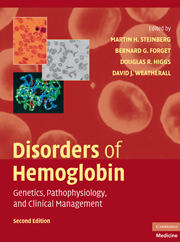Book contents
- Frontmatter
- Contents
- List of Contributors
- Foreword, by H. Franklin Bunn
- Preface
- Introduction, by David J. Weatherall
- SECTION ONE THE MOLECULAR, CELLULAR, AND GENETIC BASIS OF HEMOGLOBIN DISORDERS
- SECTION TWO PATHOPHYSIOLOGY OF HEMOGLOBIN AND ITS DISORDERS
- SECTION THREE α THALASSEMIA
- SECTION FOUR THE β THALASSEMIAS
- SECTION FIVE SICKLE CELL DISEASE
- SECTION SIX OTHER CLINICALLY IMPORTANT DISORDERS OF HEMOGLOBIN
- SECTION SEVEN SPECIAL TOPICS IN HEMOGLOBINOPATHIES
- SECTION EIGHT NEW APPROACHES TO THE TREATMENT OF HEMOGLOBINOPATHIES AND THALASSEMIA
- 29 Transfusion and Iron Chelation Therapy in Thalassemia and Sickle Cell Disease
- 30 Induction of Fetal Hemoglobin in the Treatment of Sickle Cell Disease and β Thalassemia
- 31 Novel Approaches to Treatment
- 32 Stem Cell Transplantation
- 33 Prospects for Gene Therapy of Sickle Cell Disease and Thalassemia
- Index
- Plate section
- References
30 - Induction of Fetal Hemoglobin in the Treatment of Sickle Cell Disease and β Thalassemia
from SECTION EIGHT - NEW APPROACHES TO THE TREATMENT OF HEMOGLOBINOPATHIES AND THALASSEMIA
Published online by Cambridge University Press: 03 May 2010
- Frontmatter
- Contents
- List of Contributors
- Foreword, by H. Franklin Bunn
- Preface
- Introduction, by David J. Weatherall
- SECTION ONE THE MOLECULAR, CELLULAR, AND GENETIC BASIS OF HEMOGLOBIN DISORDERS
- SECTION TWO PATHOPHYSIOLOGY OF HEMOGLOBIN AND ITS DISORDERS
- SECTION THREE α THALASSEMIA
- SECTION FOUR THE β THALASSEMIAS
- SECTION FIVE SICKLE CELL DISEASE
- SECTION SIX OTHER CLINICALLY IMPORTANT DISORDERS OF HEMOGLOBIN
- SECTION SEVEN SPECIAL TOPICS IN HEMOGLOBINOPATHIES
- SECTION EIGHT NEW APPROACHES TO THE TREATMENT OF HEMOGLOBINOPATHIES AND THALASSEMIA
- 29 Transfusion and Iron Chelation Therapy in Thalassemia and Sickle Cell Disease
- 30 Induction of Fetal Hemoglobin in the Treatment of Sickle Cell Disease and β Thalassemia
- 31 Novel Approaches to Treatment
- 32 Stem Cell Transplantation
- 33 Prospects for Gene Therapy of Sickle Cell Disease and Thalassemia
- Index
- Plate section
- References
Summary
INTRODUCTION
The beneficial effects of high levels of fetal hemoglobin (HbF) in sickle cell disease and β thalassemia have been recognized for many years. In 1948, Watson et al. noted that newborns with sickle cell disease do not suffer from the clinical complications of their disease until HbF declines to adult levels after the first 6 months of life. Later, it was shown that the majority of patients with sickle cell disease from some regions of Saudi Arabia and India who co-inherit another genetic determinant associated with high HbF levels, have a very mild sickling disorder. More recently, the Cooperative Study of Sickle Cell Disease, a large multicenter study of the natural history of sickle cell disease (see Chapter 19) demonstrated an inverse correlation between HbF levels and the frequency of painful crises and early death. These clinical and epidemiological observations are supported by laboratory studies that demonstrate a sparing effect of HbF on polymerization of deoxyhemoglobin S. Similarly, in β thalassemia, an increase in the synthesis of fetal γ-globin chains may decrease the imbalance between α- and non-α-globin chains and ameliorate the severity of the anemia. This appreciation of the beneficial effects of HbF in sickle cell disease and β thalassemia stimulated a great deal of interest in the development of therapeutic agents to increase HbF production in patients with these disorders.
- Type
- Chapter
- Information
- Disorders of HemoglobinGenetics, Pathophysiology, and Clinical Management, pp. 745 - 754Publisher: Cambridge University PressPrint publication year: 2009
References
- 5
- Cited by



